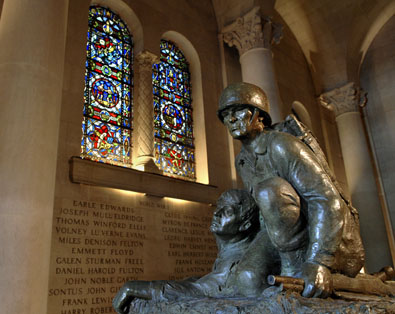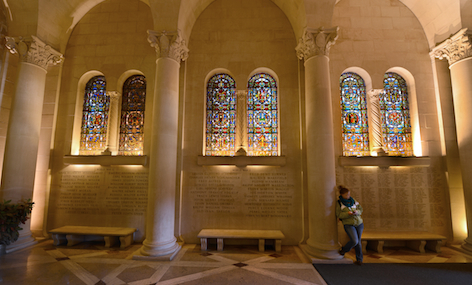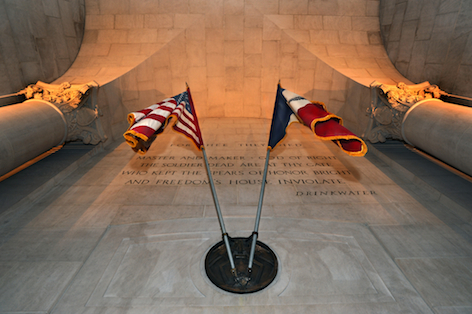
This Memorial Day, we would like to recognize the mechanical engineering students and alumni who have given the ultimate sacrifice while serving their country. All of the names on this list are also inscribed on the walls of the Gold Star Hall inside the Memorial Union.
World War I
Pvt. Harold Allen – Harold Allen came to Iowa State as part of the Mechanical Training Detachment, Company A. The Sutherland, Iowa-native died of influenza at Iowa State College in 1918.
LDS Charles Bilderback – (Landsman) Charles Bilderback served as a mechanic’s mate in naval aviation at the Great Lakes Naval Training Station in Illinois. The Adel, Iowa-native died of pneumonia following the influenza outbreak in 1918
Pvt. Laurence Caspor – Laurence Caspor was part of the Mechanical Training Detachment, Company A. The Hinton, Iowa-native died of influenza at Iowa State College in 1918.
Pvt. Everett Clark – Everett Clark was part of the Mechanical Training Detachment, Company B. The Cedar Falls, Iowa-native died of influenza in 1918.
Pvt. Eugene Colburn – Eugene Colburn was part of the Mechanical Training Detachment, Company B. The West Union, Iowa-native died of influenza at Iowa State College in 1918.
Pvt. Anton Dahl – Anton Dahl was part of the Mechanical Training Detachment, Company B. The Cherokee, Iowa-native died of influenza at Iowa State College in 1918.
2nd Lt. O. Dean Davidson – O. Dean Davidson earned a B.S. in Mechanical Engineering and Agricultural Engineering in 1915. The Omaha, Nebraska-native died in an airplane accident at Richmond, Texas in 1919.
2nd Lt. Matthew Eckerman – Matthew Eckerman would have graduated in 1918 with a degree in mechanical engineering but instead enlisted in Officer Training School at Fort Snelling, Minnesota in May 1917. The Des Moines-native was killed in 1918 while doing scouting work in Alsace, France, possibly by friendly fire.
Pvt. Thomas Ellis – Thomas Ellis was part of the Mechanical Training Detachment, Company A. The Spencer, Iowa-native died of influenza in 1918.
Maj. Matthew King – Matthew King graduated with a B.M.E. in 1906. The Indianapolis-native was a major in aviation and died in Fort Sheridan, Illinois in 1919.
Pvt. Ralph Kirk – Ralph Kirk graduated with a B.S. in mechanical engineering in 1916. The Dunlap, Iowa-native died of pulmonary tuberculosis in 1919 while serving with the army of occupation in Coblenz, Germany.
Pvt. Henry Larson – Henry Larson was part of the Mechanical Training Detachment at Iowa State. The Story City, Iowa-native died of influenza at Iowa State College in 1918.
Pvt. Wendal Macy – Wendal Macy was part of Mechanical Training Detachment Company B. The Searboro, Iowa-native died of influenza at Iowa State College in 1918.
Pvt. William Martin – William Martin was part of the Class of 1920 and studied mechanical engineering at Iowa State. The Odebolt, Iowa-native died of influenza at Iowa State College in 1918.
Pvt. Everett Marvin – Evertt Martin was part of Mechanical Training Detachment Company B. The Waterloo-native died of influenza at Iowa State College in 1918.
Pvt. Ehrhardt Michaelsen – Ehrhardt Michaelsen was part of the Mechanical Training Detachment. The Arion, Iowa-native died of influenza at Iowa State College in 1918.
Cpl. William Moore – William Moore studied mechanical engineering at Iowa State. The Des Moines-native died of pneumonia (possibly flu-related) at Camp Meade in Maryland in 1918.
Pvt. Philip Mueller – Philip Mueller came to Iowa State as part of the third Mechanical Training Detachment, Company B. The Hudson, Iowa-native died of influenza at Iowa State College in 1918.
Pvt. Cale Neal – Cale Neal came to Iowa State as part of the Mechanical Training Detachment, Company A. The Portland, Iowa-native died of influenza at Iowa State College in 1918.
Pvt. Clarence Nelson – Clarence Nelson came to Iowa State as part of the Mechanical Training Detachment, Company B. The Jewell, Iowa-native died of influenza at Iowa State College in 1918.
Pvt. Carl Polson – Carl Polson came to Iowa State as part of the Mechanical Training Detachment, Company A. The Indianola, Iowa-native died of influenza at Iowa State in 1918.
Pvt. James Powers – James Powers came to Iowa State as part of the Mechanical Training Detachment, Company B. The Duncomb, Iowa-native died of influenza at Iowa State College in 1918.
Pvt. William Reints – William Reints came to Iowa State as part of the mechanical training corps. The Stanton township, Iowa-native died of influenza at Iowa State College in 1918.
Pvt. Peter Sand – Peter Sand came to Iowa State as part of the Mechanical Training Detachment, Company B. The Dubuque, Iowa-native died of influenza at Iowa State College in 1918.
Pvt. Lester Schoech – Lester Schoech came to Iowa State as part of the Mechanical Training Detachment, Company B. The Ottumwa, Iowa-native died of influenza at Iowa State College in 1918.
1st Lt. Charles Schumacher – Charles Schumacher received a B.S. in mechanical engineering from Iowa State in 1912. He worked as a civilian engineer at the air field at Fort Sill, Oklahoma and enlisted as a private there in October, 1917. He died at the aviation repair depot in Montgomery, Alabama in 1919.
Pvt. Lowell Sheldon – Lowell Sheldon was part of the Mechanical Training Detachment, Company A at Iowa State. The Eldora, Iowa-native died of influenza at Iowa State College in 1918.
Pvt. Tracy Sparks – Tracy Sparks was part of the Mechanical Training Detachment, Company B at Iowa State. The Kellogg, Iowa-native died of influenza at Iowa State College in 1918.
Pvt. Ralph Warrington – Ralph Warrington was part of the Mechanical Training Detachment, Company B at Iowa State. He died of influenza at Iowa State College in 1918.
Pvt. Frank Waugh – Frank Waugh was part of the Mechanical Training Detachment at Iowa State. He died of influenza at Iowa State College in 1918.
Pvt. John Wilmes – John Wilmes was part of the Mechanical Training Detachment, Company A at Iowa State. The LaMotte, Iowa-native died of influenza at Iowa State College in 1918.
Pvt. Pearl Yates – Pearl Yates was part of the Mechanical Training Detachment at Iowa State. The Albia, Iowa-native died of influenza at Iowa State College in 1918.

World War II
Lt. Donald Arp – Donald Arp graduated with a degree in mechanical engineering in 1938 and served as an assistant plant manager at Deere and Mansur in Moline, Illinois. He enlisted in the army in 1941 and served in the Philippines. Arp was captured by Japanese forces during the fall of the Philippines in December 1942. He died aboard a Japanese transport ship that sank on December 7, 1944.
ENS. John Estel – John Estel graduated with a B.S. in mechanical engineering at Iowa State in 1938. John’s father Edward was a 1910 graduate of the dairy program at Iowa State. John Estel worked for the Pittsburgh Des Moinse Steel Company after college and enlisted in the navy in 1943. The Waterloo, Iowa-native died just ten day later (on July 1, 1943) when a plane carrying Estel and another ensign crashed near Fremont, Iowa.
ENS. Gerald Cleckner – Gerald Cleckner graduated with a B.S. in mechanical engineering at Iowa State in 1943. After graduation the Webster City, Iowa-native worked as an engineer for Thompson Product Company. He joined the Navy in June 1944 and was deployed to the South Pacific in September 1944. On January 9, 1945, Cleckner and three other officers received permission to leave the USS Arided to take a motorboat to Fatato Island for a fishing party. About 100 yards offshore the officers decided to swim the rest of the way to the island but Cleckner struggled with the swim and ended up drowning.
Cpt. Henry Paul – Henry Paul graduated with a degree in mechanical engineering in June 1941 and was called to service in January 1942. The Mahwah, New Jersey-native served with the 2943 Engineer Technical Intelligent Team and died in an automobile accident while investigating enemy weapons and equipment in Euskirchen, Germany on April 3, 1945.
Maj. Edwin Pumroy – Edwin “Red” Pumroy become a second lieutenant in the Engineering reserves on December 20, 1930 and graduated with a degree in mechanical engineering at Iowa State in 1931. The Ottumwa, Iowa-native was called to duty in 1941 and promoted to major in 1942. He died on his 37th birthday while leading a patrol near Champenoux, France on September 22, 1944.
Lt. j.g. Richard Suesens – Richard Suesens graduated with a B.S. in mechanical engineering from Iowa State in 1938. The Burlington, Iowa-native enlisted in the navy in 1938 and was promoted to Lieutenant (Junior Grade) in 1941. Suesens was among 10 pilots shot down by Japanese forces during the Battle of Midway in June 1942. Initially the War Department listed Suesens as “Missing In Action” but he was presumed dead in June 1943. Suesens is listed on the Tablets of the Missing at the National Memorial Cemetery of the Pacific in Honolulu, Hawaii. The USS Richard W. Suesens (Destroyer Escort; DE-342) was launched on January 11, 1944 and commissioned on April 26, 1944.
Korean War
1st Lt. Thomas Odenbaugh – Thomas Odenbaugh came to Iowa State in 1943 to study mechanical engineering. The Ottumwa, Iowa-native enlisted in the Marines (in the Naval Air Corps) in 1944. He served in WWII and upon his discharge in 1948, enlisted in the reserves. He continued his mechanical engineering studies at Iowa State from 1948 to 1950. In 1950 Odenbaugh was called up from the reserves to serve in the Korean War. On Sept. 29, 1950, the helicopter that Odenbaugh was riding in was shot down about fourteen miles north of Seoul, South Korea. When U.S. troops were able to access the crash site several days later, they found remains for the aerial observer on-board the helicopter with Odenbaugh but remains for Odenbaugh were not found. In September 1953 a number of prisoners captured by North Korean forces were released, but Odenbaugh was not among them and none of the released prisoners had any evidence that he had been held prisoner with them. Many years later, a report indicated that Odenbaugh’s name was found scratched into the wall of a jail cell in Pyang Yang, North Korea, dated October 6, 1950. A declaration was made in December 1953 assuming that Odenbaugh had died. He was one of over 8000 American servicemen missing at the Korean War that have never been returned or accounted for.
Vietnam War
5 Cl. Spec. Dennis Kouhns – Dennis Kouhns briefly studied Mechanical Technology at Iowa State. He was drafted in either 1965 or 1966. The Ogden, Iowa-native arrived in Vietnam in 1967 and served as a tracked vehicle mechanic, assigned to the 1st cavalry regiment and attached to the 4th Infantry Division. On January 30, 1968, Kouhns’s base camp came under heavy enemy attack in what became known as the Tet Offensive. He died at the age of 21 from wounds inflicted by an exploding mortar.
Maj. Delbert Peterson – Delbert Peterson graduated from Iowa State with a degree in mechanical engineering in 1962 and was commissioned as a 2nd Lieutenant in the US Air Force Reserve. In November 1965 Peterson was assigned to the 4th Air Commando Squadron (Fire Support), 14th Air Commando Wing, Tan Son Nhut Air Base, Vietnam, Seventh Air Force, where he co-piloted an AC-47. During a rescue mission in 1966, Peterson and his crew were forced to make a crashing landing on a mountain slope. While waiting for the rescue helicopter to arrive, Peterson and the crew had to defend against energy fire to allow the helicopter to land. Peterson then charged enemy gunmen, firing his M-16, which enabled the helicopter to land and rescue the crew members, minus Peterson. Peterson was last seen “crawling behind the crashed AC-47 to take up a position to secure the aircraft.” After about 20 minutes a Special Forces ground team arrived to rescue Peterson but aside from “blood spots leading away from the crash site” were unable to find any evidence of Peterson. The Manson, Iowa-native was presumed to have been captured and was officially listed as Missing in Action. Peterson’s father Raymond, was briefly captured during WWII, and remained optimistic that his son might still be alive. The younger Peterson was eventually promoted to the rank of major and in February 1978 his status was changed to killed in action. In the mid-1990s, several items including his ID tag and a religious medal were discovered near the crash site, but his remains were never found.
Please contact Communications Specialist Nick Fetty (nrfetty@iastate.edu, 515-294-5065) if you know of any names or other information not included on this list
